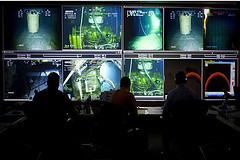August 2, 2010
by Traci Gardner
 It’s politically correct to be disappointed with BP and their little oil well problem in the Gulf. But how can I be angry when they provide me with such wonderful gifts?
It’s politically correct to be disappointed with BP and their little oil well problem in the Gulf. But how can I be angry when they provide me with such wonderful gifts?
First, BP America digitally enhanced some of their oil spill clean-up photos. The images are great for pointing out the sloppiness of the Photoshop work and, more importantly, discussing the ethical issues related to tampering with the images. Be sure to look at the face-saving explanation BP has posted with the BP Altered Images Flickr set. Any class exploring visual rhetoric should spend time with these photos. So a big thank you to BP for classroom material.
But that’s not all. Next, the folks over at Wired took the faked BP images and challenged readers to create their own digitally altered photos. The results are marvelous. Everything from Godzilla to Rick Astley is out there in the Gulf causing mayhem.
The submission showing pop culture images on the different monitors is probably my favorite:

How could you NOT like an image that includes Max Headroom, War Games, Star Trek, Poltergeist, and The Matrix?
As part of a visual rhetoric lesson plan, the Wired challenge images open up the topic of satire and parody. Students can discuss how the different images critique the way BP has handled the oil spill—both in its actual clean-up and in the images they have shared with the public.
So politically correct or not, I’m a little thankful to BP America for providing me with the materials for a timely lesson on an important topic.
[Creative Commons licensed Flickr photo by BP America]
 This week’s post on Bedford Bits describes the work I have begun on revising my course documents to make them more visual. The ultimate goal is to make them more engaging and more useful to students.
This week’s post on Bedford Bits describes the work I have begun on revising my course documents to make them more visual. The ultimate goal is to make them more engaging and more useful to students. 

